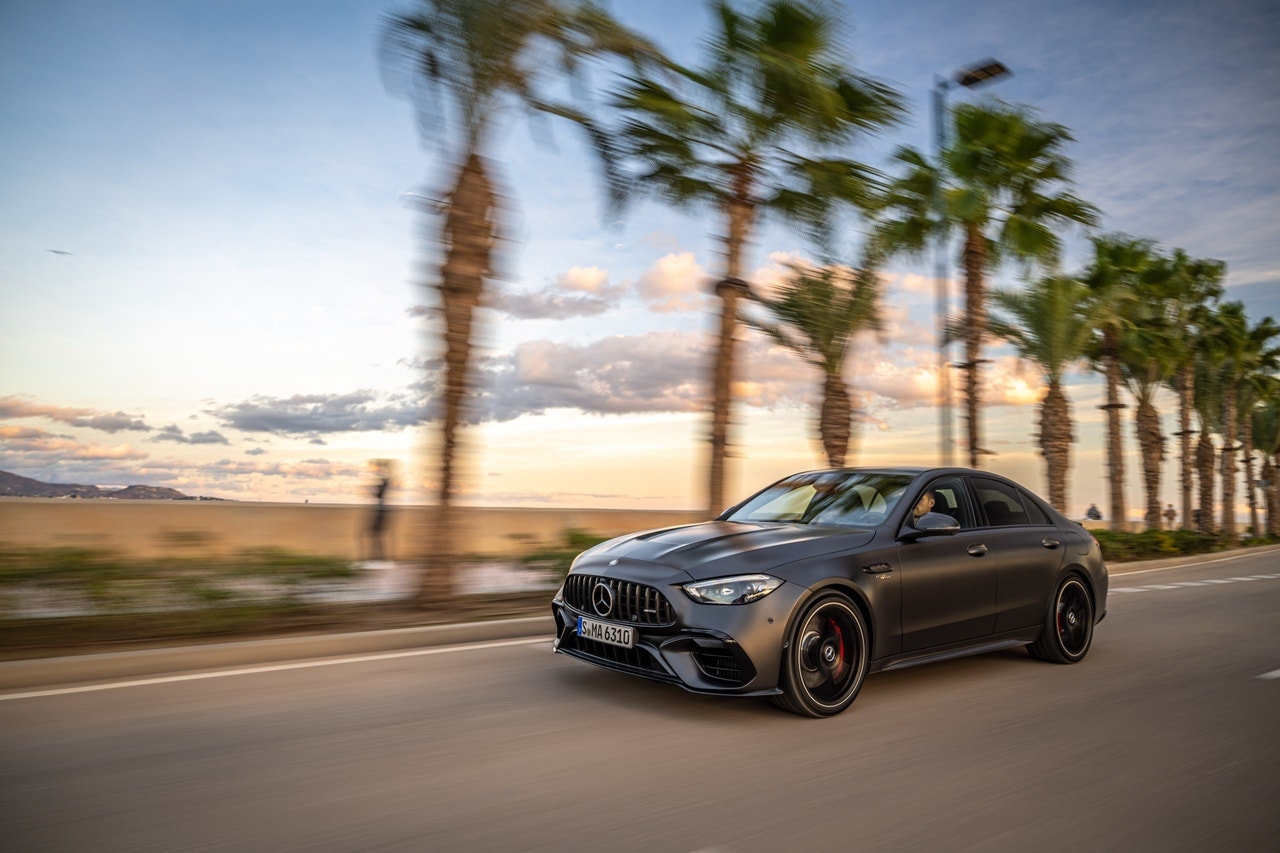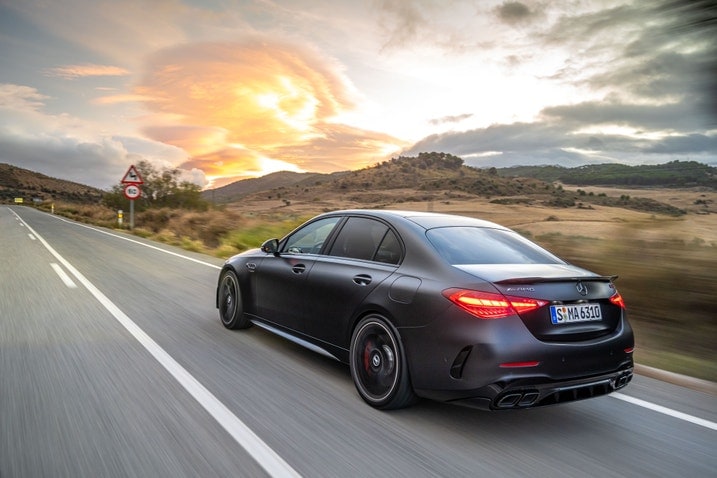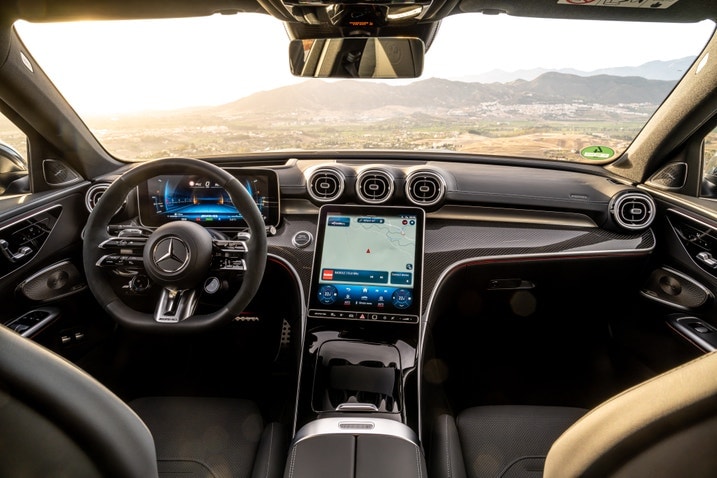- The C 63 returns for 2024, now as the AMG C 63 S E Performance.
- It swaps out the previous C 63's V8 for a turbo inline-four plug-in hybrid.
- All-wheel drive and four-wheel steering are standard.
2024 Mercedes-AMG C 63: Fast and Technically Proficient But Personality-Deficient
Increased power and capability come at the expense of entertainment
The 2024 Mercedes-AMG C 63 S E Performance has a name that's almost as complex as the cutting-edge drivetrain that powers it. Benz's latest iteration of its highest-performance C-Class builds on the polished compact sedan's refined chassis with an unusual four-cylinder plug-in hybrid powertrain augmented with an electrically assisted turbocharger. Losing the trademark V8 of previous C 63 generations and adding all-wheel drive amounts to nothing less than a personality transplant for this highly capable sedan.
There's ample evidence that the new C 63 can deliver stunning levels of performance and technology. But in its battle against the Audi RS 5 and BMW M3, the C 63 has always been about mainlining soul-stirring feedback as much as it's been about objective performance. Does this radical new formula still deliver?
What's under the hood? Everything AMG can think of
Like all current C-Class models, the C 63 is primarily driven by a 2.0-liter four-cylinder engine. However, unlike other C-Class models, the C 63's powerplant uses an electrically assisted turbocharger fed by a 400-volt electrical system. The electric motor helps reduce turbo lag and quicken responsiveness. All-in, this hand-built engine develops 469 horsepower. For those keeping track, that's nearly double the output of the base C 300's four-cylinder, and the torque bump from 295 lb-ft to 402 lb-ft is impressive. For the first time in the C 63's history, power is fed to all four wheels courtesy of a nine-speed automatic transmission with paddle shifters.
Just as the electric turbo isn't this car's only innovation, the M139l engine isn't the C 63's only power source. There's a meaty 150-kW electric motor mounted at the rear axle paired to an electronically controlled limited-slip differential and, unusually, a two-speed gearbox. The motor primarily powers the rear axle, funneling energy to the front wheels when slippage is detected.
Since electric motors develop maximum torque from zero rpm, utilizing the two-speed transmission assures there's abundant passing power when the motor is operating at high speed. This is a setup designed to prioritize performance over efficiency.
Between its two power sources, the C 63 generates a jaw-slackening maximum output of 671 hp and 752 lb-ft of torque. Note that this is only available for brief periods, as the electric motor limits its max 201-hp boost to 10-second bursts. After that, output falls to a still significant 94 hp. Mercedes says the C 63 will blitz from a standstill to 62 mph (100 kph) in 3.3 seconds. That's about half-second quicker than the old C 63, and it won't quit until it hits 174 mph.
While the C 63 is a plug-in hybrid, its 6.1-kWh battery pack is modestly sized and its 3.7-kW onboard charger isn't designed for particularly high-speed charging. Furthermore, EV range on a full charge is estimated at just 8 miles. Thankfully, there's a Hold Battery setting to preserve juice for city centers and an Electric mode for creeping out of the driveway in the early morning without firing the engine.
The C 63 isn't all about forward attack, of course. Extreme stopping and cornering performance are other AMG hallmarks, and the C 63 kicks things off with six-piston brakes up front (the rear uses a single), and we wouldn't be surprised if carbon-ceramics eventually made an appearance on the options list. On the handling side, the C 63 comes standard with adaptive dampers with three settings — Comfort, Sport and Sport+ — and rear-axle steering, which tightens the turning radius at low speeds and offers increased vehicle stability at high speeds.
A different flavor of sport sedan
Downsizing and electrification clearly agree with the C 63's spec sheet, but what about its demeanor? A drive across southern Spain, which is where Mercedes hosted the C 63's media launch event, and a couple of hot-lap sessions at a racetrack reveal this is a C 63 like none before. If there has been a more radical transformation of a single model's powertrain and character between generations, we haven't experienced it. Whereas previous C 63s were renowned for their V8 bellow and gloriously unhinged rear-drive nature, this generation is marked out by its sophistication and polish.
On track, the C 63 occasionally feels like it could use more grip than its Michelin Pilot Sport 4 S rubber can muster. But on the region's winding coastal roads, the tires' blend of stick and ride compliance is well chosen. With so much power, you might reasonably expect this sedan to be a twitchy, high-strung beast. It's not. That's partly because AWD gets all that power down smoothly and without drama, and partly because the addition of four-wheel steering results in adroit cornering.
But a key component in the C 63's newfound civility is AMG's decision to carefully silo the powertrain's boost reserves depending on drive mode. The computer won't unlock full boost outside of the car's Race mode, and you still have to carpet the pedal and push past the accelerator's kickdown detent. Even Sport+ only activates 80% boost. This car doesn't feel like it has nearly 700 horsepower because, most of the time, it doesn't.
Unfortunately, all of this means that outside of Drift mode — the hilariously rewarding tail-happy-but-controllable nature intrinsic to C 63s of yore — is utterly absent, smothered under the heavy weight of batteries and sophisticated electronics. Mercedes says the C 63 weighs 4,828 pounds, which is already over 900 pounds more than an AMG C 43.
This is further compounded by the lack of a stirring soundtrack. Yes, Sport+ and Race trigger more aggressive noises (electronically augmented sounds are piped through a series of speakers both inside and outside the car), but it's not the same. AMG engineers may blame the increasingly draconian pass-by noise regulations in various world markets, but we suspect that existing C 63 owners will nonetheless be disappointed by how straight-laced this new model sounds.
Another thing that takes a little getting used to when driving hard? Slowing down. There are various user-selectable levels of regenerative braking, from Level 0, which feels like braking in a traditional gas car, to Level 3, which is similar to the one-pedal mode found on most EVs. That's all well and good, and pedal feel is pretty good. But it can take a bit more pressure than one might expect to slow from very high speeds on track, likely an artifact of the C 63 weighing just 240 pounds less than the last Mercedes S-Class (S 580 4Matic) that we tested.
High-end accommodations only
The C 63's luxurious cabin doesn't stray too far from that of the standard C-Class, but there are a few noteworthy additions. The cabin's most noticeable change is a pair of firmer, more heavily bolstered AMG sport seats (even more aggressive AMG performance chairs are optional, albeit overkill if you aren't planning frequent track days). Additionally, an AMG-specific steering wheel includes clever pod-like control arrays for tailoring the car's performance characteristics, including a drive mode selector, suspension settings and the aforementioned adjustable regenerative braking.
Like other current-generation C-Class models, the C 63 benefits from Benz's slick and responsive MBUX infotainment suite, which runs through a 11.9-inch portrait-oriented touchscreen. In addition to features like wireless connectivity for Apple CarPlay and Android Auto as well as a clever augmented reality overlay for navigation, the C 63 receives dedicated performance-settings menus, as well as model-specific Supersport and Track Pace layouts for the gauge cluster display. There's even a fingerprint scanner to load individual driver profiles.
Edmunds says
The Mercedes-Benz AMG C 63 S E Performance is outrageously capable and bests its already impressive predecessor in nearly every performance metric. But something has been lost in the move to partial electrification. This new generation's limits are so high as to only be exploitable on track, and the electronics won't allow you to access its full potential under most circumstances anyway. The C 63 used to be Germany's muscle car, Stuttgart by way of NASCAR. Now, it's a technological juggernaut and an important transitional step on Benz's roadmap to going fully electric by 2030. Unfortunately, with all that weight and complexity, and with so little noise, it's not nearly as much fun.









 by
by